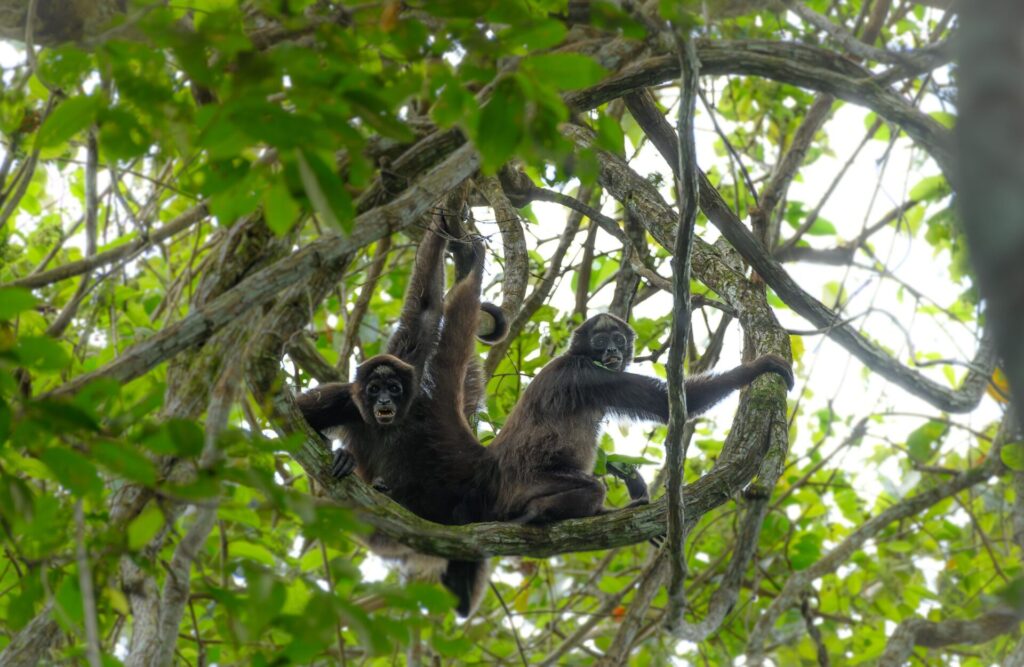Swinging through the canopy of the El Silencio Reserve is the Critically Endangered Brown Spider Monkey (Ateles hybridus). It is here, in Colombia’s Middle Magdalena Valley that World Land Trust’s (WLT’s) Autumn Appeal is supporting conservation partner Fundación Biodiversa Colombia (FBC) to expand El Silencio before it’s too late.
We spoke to primatologist Dr Andrés Link, who has spent the past 20 years studying these unusual primates:
Andrés Link, together with his wife Gabriela de Luna, co-founded Fundación Proyecto Primates, an NGO dedicated to primate conservation. Both are also closely involved with Fundación Biodiversa Colombia’s (FBC’s) work in the El Silencio Reserve.
Why are these exciting species to study?
“Brown Spider Monkeys are among the largest monkeys in Colombia, and are mostly found only in Colombia, and in a tiny area of Venezuela. They are fascinating animals to study.
Like all primates, they form strong social bonds, but their societies are unusually fluid. Groups may contain 20 to 30 individuals, sometimes fewer, sometimes more, coming together and splitting apart with great flexibility. This makes them especially interesting to study. We see how they adapt depending on food availability, predation risk, or environmental pressures.
For example, when food is plentiful, groups may split into smaller units; when threats are higher, they join larger groups for protection.”
The Brown Spider Monkey is vulnerable to predation from Jaguars (Panthera onca) and Crested Eagles (Morphnus guianensis). For this reason, there is strength in numbers. Credit: Fundación Biodiversa Colombia (FBC)
Tell us more about the importance of El Silencio
“Around 2005, I came to Colombia to look for the Brown Spider Monkey, and one of the first places the team and I visited was El Silencio. There, we met the local community and discovered healthy populations of spider monkeys. It was very encouraging, and El Silencio has since become central to studying and protecting these primates and the forests they inhabit.
In fact, one of Colombia’s most significant populations of Brown Spider Monkeys is found in El Silencio Reserve in the Magdalena River Valley.”
El Silencio Reserve is a major stronghold for the Brown Spider Monkey, with vast forests sustaining healthy populations. Credit: Fundación Biodiversa Colombia (FBC)
Do the monkeys play an important role in conservation?
“YES! Spider monkeys are critically important for the forests, playing a vital ecological role as seed dispersers. They eat fruits and swallow seeds, spreading them across wide areas. In doing so, they help plant the forests of tomorrow. In a sense, they are continuing the legacy of their ancestors: the “grandparents” of the forest who planted the landscapes we see today.
Since these charismatic monkeys require very good, intact forests, they are also early indicators of the health of their habitat, acting as a sentinel species.
Brown Spider Monkeys play a huge role in forest conservation. By eating large amounts of fruit, they are major seed dispersers – keeping the forest going for future generations. Credit: Fundación Biodiversa Colombia (FBC)
We know that populations are declining rapidly because forest loss in their home ranges is accelerating. This is why the current conservation appeal to expand El Silencio is so important and so urgent.
If we act now, we can ensure that these forests and species survive for the future. This is not only about protecting the Brown Spider Monkey; it is about safeguarding a beautiful, irreplaceable haven for biodiversity in the Magdalena Valley.
Help us expand El Silencio and save forest, wetlands and wildlife from destruction before it’s too late.

